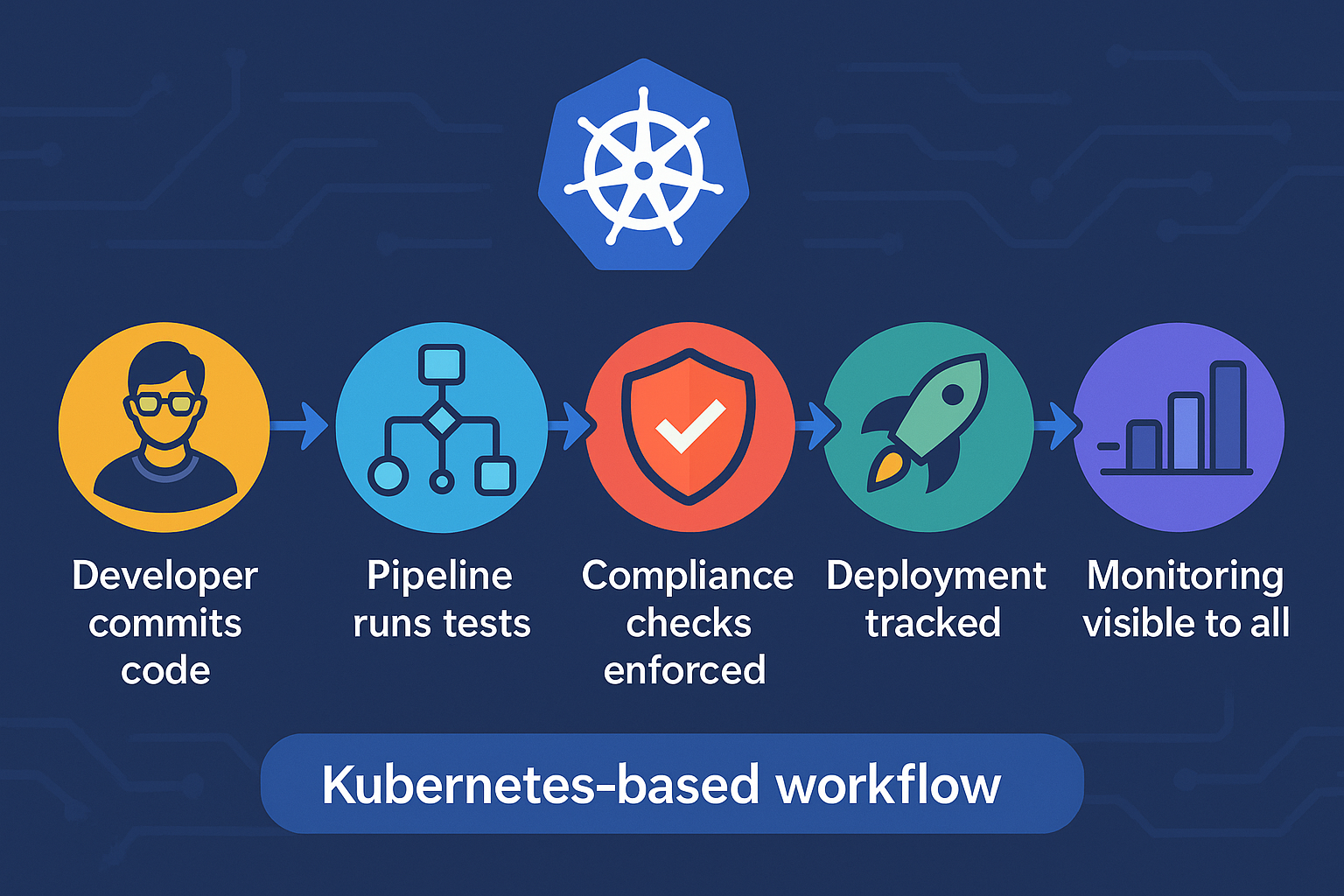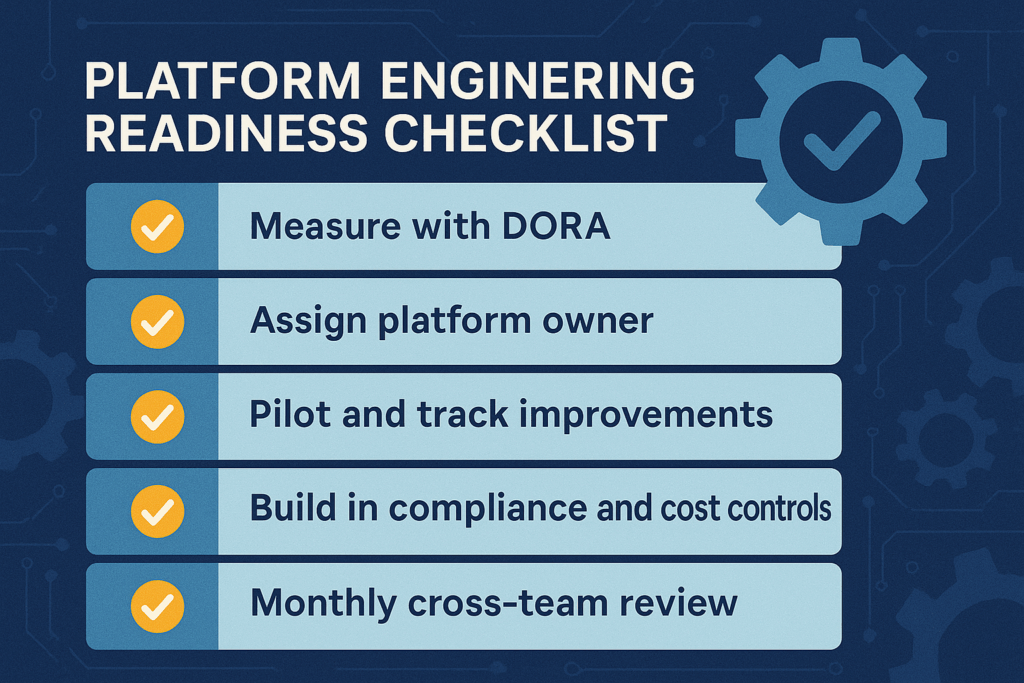
TL;DR
Platform engineering for enterprise agility is a discipline, not a passing fad. Organisations like Volkswagen and Walmart show that clear ownership, automation, and evidence-based action consistently drive faster and safer change.
Introduction: Where Platform Engineering Matters
Three years ago, I worked with a scale-up to address repeated deployment delays. Despite capable teams and modern cloud tooling, releases stalled for days, blocked by manual reviews and unclear responsibilities. By establishing a dedicated platform team and removing friction, we halved the release cycle within a quarter.
This scenario is common. Platform engineering for enterprise agility closes the gap between expensive technology and what genuinely reaches users. The cases below show what works, and why discipline matters more than tools.
The Enterprise Reality
The hype around platform engineering is justified only when results are measured. The CNCF 2023 Annual Survey shows 75 percent of organisations use Kubernetes to automate deployments. Despite this, fewer than one in five achieve top-tier delivery speed or reliability, as reported by DORA 2023.
Cloud waste remains a persistent issue. Flexera’s 2024 State of the Cloud Report found 32 percent of spend is wasted, often due to misaligned priorities or lack of clear ownership.
In the UK, the engineering skills gap continues. EngineeringUK reports most firms struggle to fill platform and DevOps roles.
The core barriers are not tools or frameworks, but clarity: who owns delivery, and how teams measure success.
A Practical Framework for Platform Engineering

Figure 1: Kubernetes-based pipeline, as used by Volkswagen, automating testing and compliance checks to cut test costs by 50 percent (see step three).
I recommend a six-step framework based on results from large organisations:
- Set Outcomes and Metrics
Avoid implementing platform engineering for its own sake. Use DORA metrics such as deployment frequency, lead time for changes, and change failure rate. These indicate whether the organisation is moving faster while maintaining quality. - Treat the Platform as a Product
Assign a platform product owner. Collect feedback from developers, operations, and security. Prioritise and resolve points of friction, and track satisfaction scores monthly. - Automate Compliance and Policy
Integrate compliance checks directly into the deployment pipeline. Use tools such as Open Policy Agent to flag issues before code is live. At Aviva, automated compliance checks reduced model approval from eight weeks to 1.6 weeks. - Standardise Workflows
Provide a single onboarding process and clear documentation for all teams. Nationwide accelerated deployments from weekly to daily and improved developer productivity by 20 percent in one year through this approach. - Align Product, Platform, and Security
Bring together product, platform, and security leads each month to review key metrics and remove obstacles. Volkswagen cut annual test costs from €4M (£3.4M) to €2M (£1.7M) in eighteen months through unified workflows and virtualisation. - Share Progress and Data
Make delivery metrics visible across teams. Transparency helps teams fix problems early and identify best practices.
Case Studies: Real Enterprise Results
Volkswagen: Virtualising Testing Infrastructure
Volkswagen previously relied on expensive physical test environments costing €4M (£3.4M) per year. By adopting a virtualised testing platform with Red Hat OpenShift, they standardised validation and achieved:
- A reduction in system test costs from €4M (£3.4M) to €2M (£1.7M) in eighteen months
- Consistent, scalable testing environments for engineering teams
- Faster development cycles with full safety compliance
Nationwide: Cloud-Native Transformation
Nationwide faced slow deployment cycles and high engineering turnover. By shifting to cloud-native architecture, they:
- Moved from weekly to daily deployments, increasing developer productivity by 20 percent within a year
- Reduced onboarding time for new developers from three weeks to one week using self-service tools
- Achieved measurable improvements in staff retention
Aviva: Production-Ready MLOps Platform
Aviva’s data scientists were held back by inconsistent tools and manual compliance checks. A new MLOps platform using Amazon SageMaker transformed delivery:
- Model deployment time reduced from eight weeks to 1.6 weeks (five times faster)
- Automated governance saved £500K per year in compliance costs
- Enabled real-time fraud detection for one million customers with full GDPR compliance
Walmart: Multi-Cloud Platform Strategy
Walmart serves ten million customers daily across multiple cloud environments. Their supercloud platform strategy delivered:
- Deployment times reduced from four hours to two hours across all global sites
- High availability through distributed, resilient architectures
- A standard workflow that improved cross-team collaboration and knowledge sharing
Where Most Teams Get Stuck
Hiring:
Platform engineering skills are in short supply. Upskilling and university partnerships enabled one UK bank to reduce hiring gaps by 25 percent through targeted training.
Cost:
Cloud costs escalate without oversight. At Nationwide, FinOps practices cut waste by 25 percent and saved £1M annually through automated usage monitoring and alerts.
Compliance:
Manual checks can delay releases for weeks. Aviva’s policy-as-code approach reduced audit time by 50 percent while upholding GDPR standards.
Tool Sprawl:
Too many tools increase complexity. Walmart reduced confusion by standardising on core patterns and a focused toolset, supporting consistent deployment across regions.
What’s Next: Trends to Watch
AI-driven operations are now integral to platform management. A European bank applied machine learning for anomaly detection, reducing production incidents by 30 percent and saving €2M (£1.7M) in downtime costs (Gartner 2024).
FinOps is becoming standard. Sixty percent of enterprises now use real-time cost tracking, with a major UK retailer cutting waste by 25 percent through automated alerts (Flexera 2024).
Zero-trust security is rising fast. Forty percent of Kubernetes users enforce identity checks at every deployment. A US fintech cut unauthorised access by 20 percent through zero-trust policies (CNCF 2023).
These trends demand platform teams that balance automation, cost control, and security while maintaining developer speed.
Immediate Next Actions
Start this week to see impact within one quarter:
- Use DORA metrics to identify three main delivery bottlenecks, such as manual approvals or legacy tooling
- Assign a platform owner to prioritise feedback and monitor satisfaction weekly
- Pilot Kubernetes or OpenShift for one team, measuring cycle time improvements every week
- Embed policy-as-code with Open Policy Agent for automated compliance
- Host monthly reviews with product, platform, and security to adjust priorities using real delivery data

Figure 2: Platform engineering readiness checklist, outlining five steps to prioritise bottlenecks, automate compliance, and align teams.
If a process or tool does not improve delivery speed or safety, replace it.
Further Reading
- Volkswagen Group DevOps Case Study
- Nationwide Building Society Transformation
- Aviva ML Data Platform
- Walmart Cloud Platform Engineering Case
- DORA State of DevOps Report 2023
- CNCF: 2023 Annual Survey
- Flexera 2024 State of the Cloud Report
- EngineeringUK: Skills and Demand in Industry 2024
- Gartner Strategic Technology Trends 2025

Leave a Reply